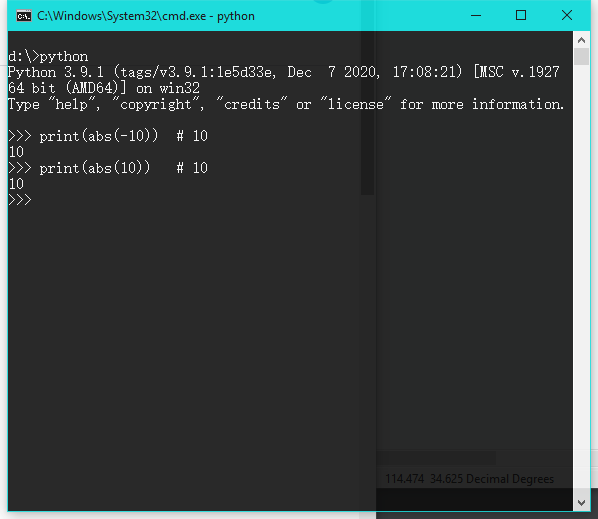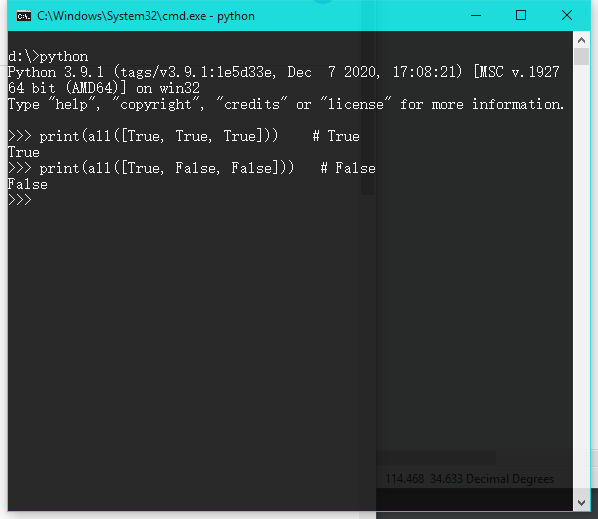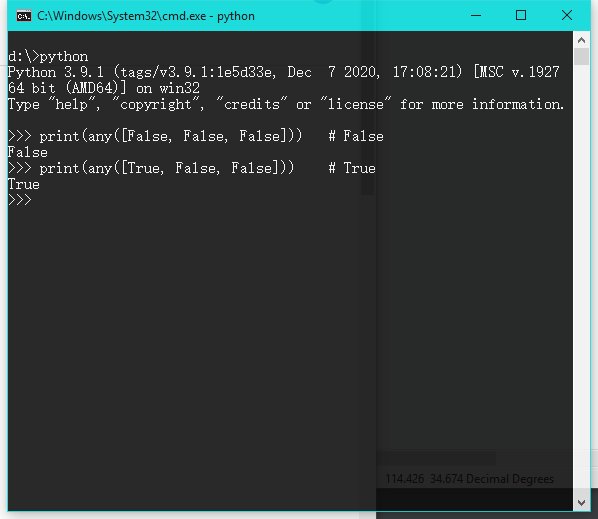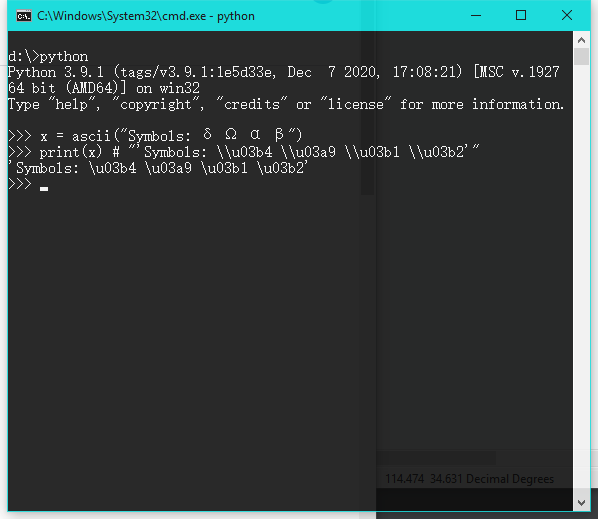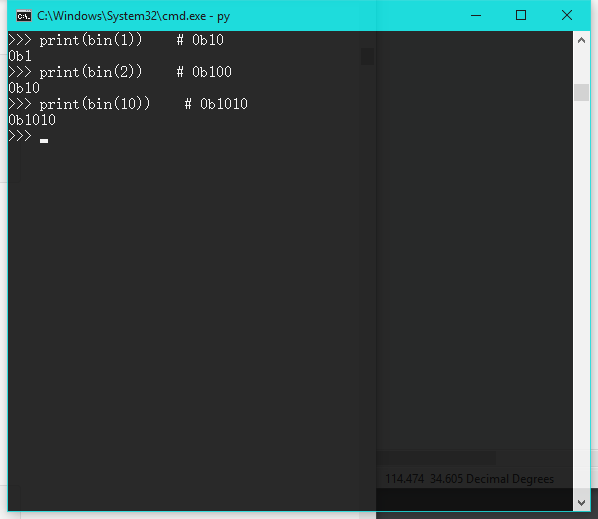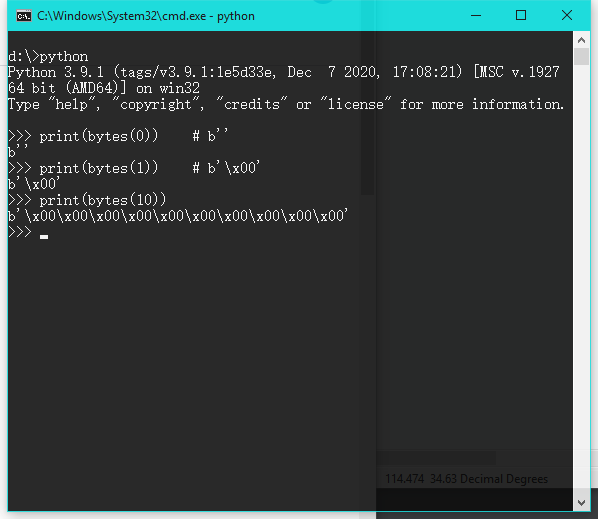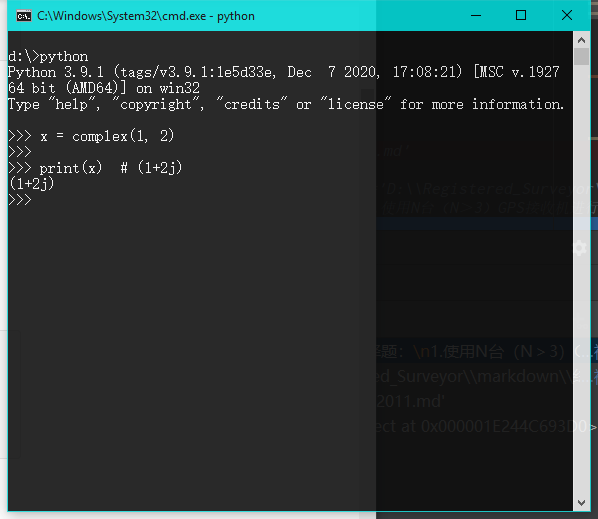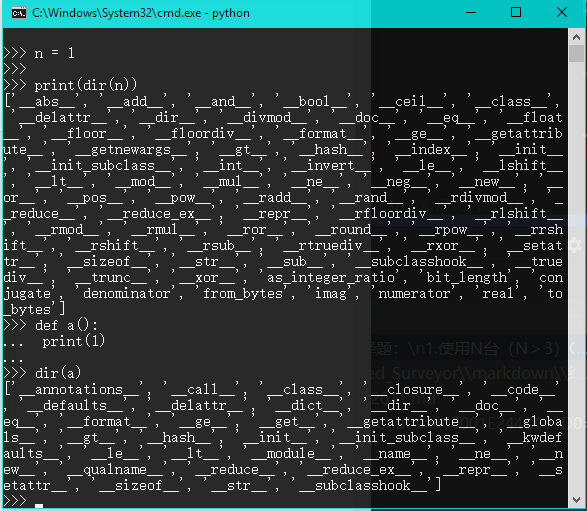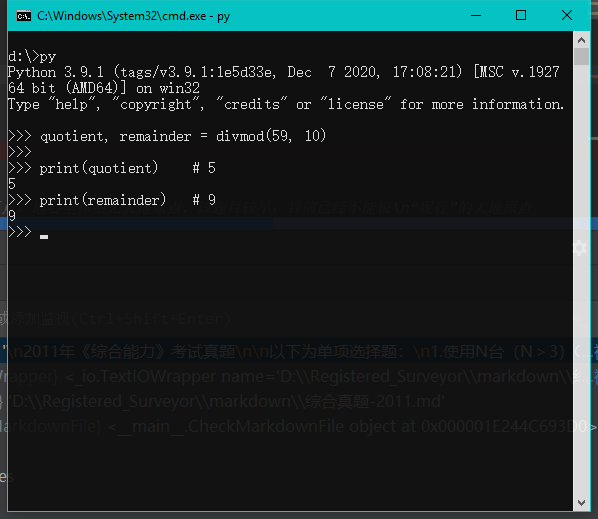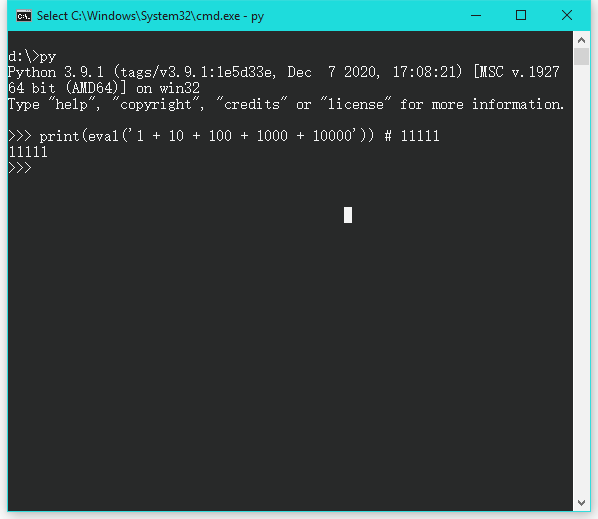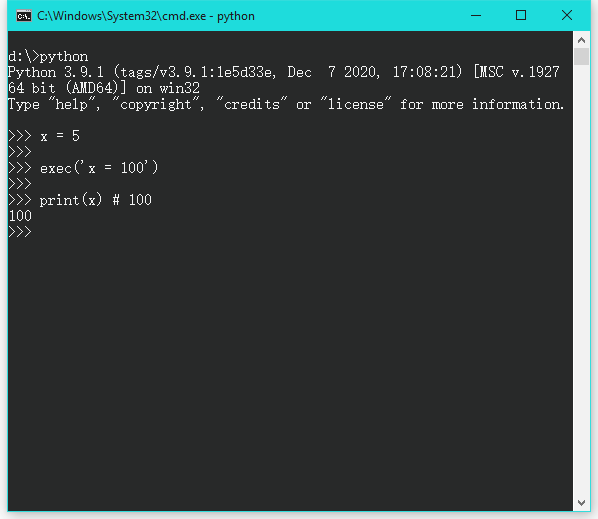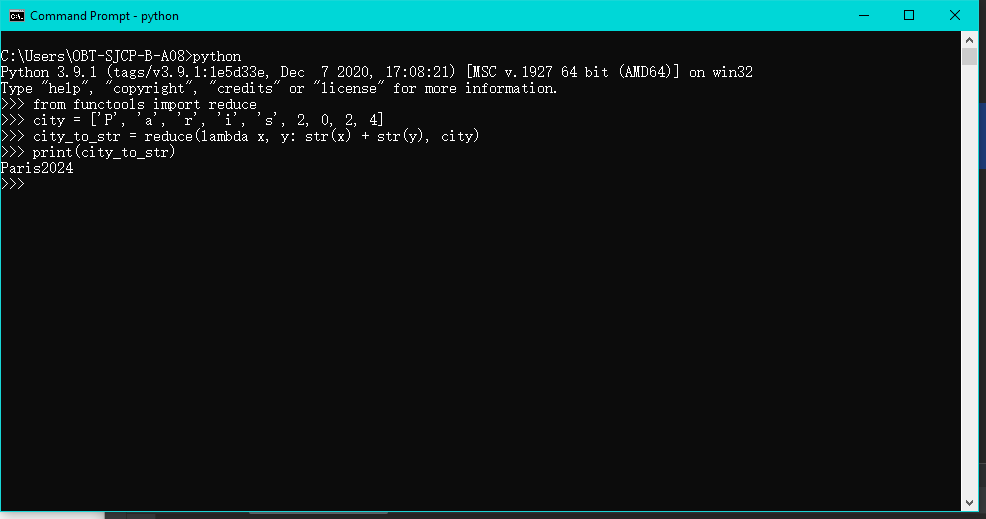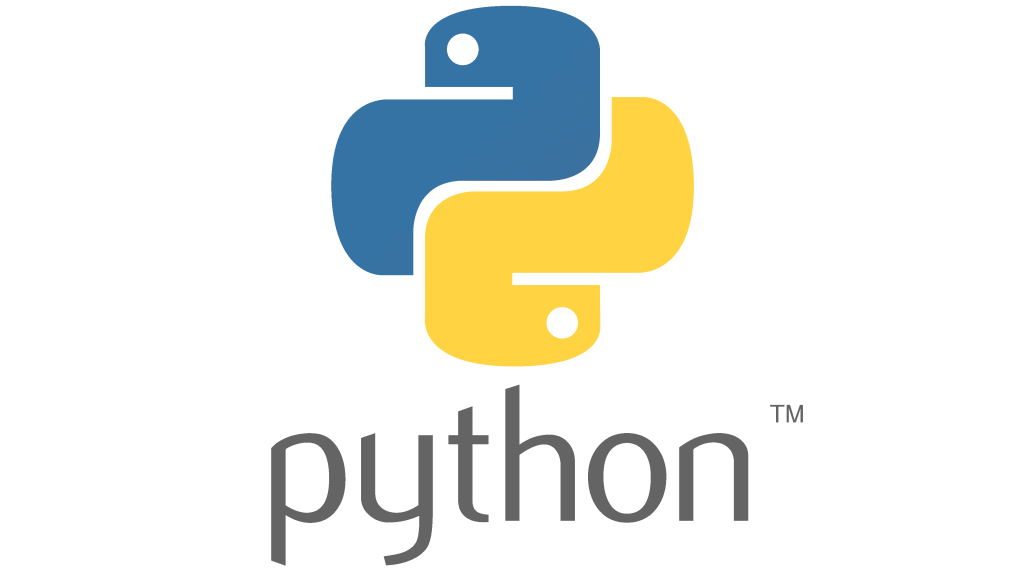Python 中每个内置函数的简明解释
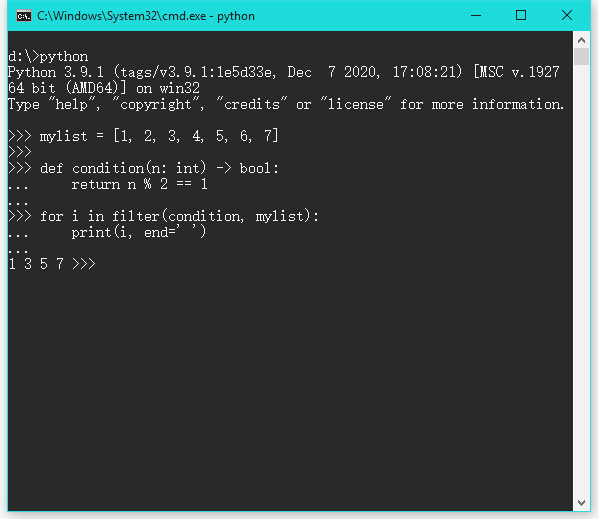
Python 中每个内置函数的简明解释
ytkzcategories: [编程,python] | 函数名 | 函数名 | 函数名 | 函数名 | 函数名 |
| abs | aiter | all | any | ascii |
| bin | bool | bytearray | bytes | callable |
| chr | classmethod | compile | complex | delattr |
| dict | dir | divmod | enumerate | eval |
| exec | exit | filter | float | format |
| getattr | globals | hasattr | hash | help |
| hex | id | input | int | isinstance |
| issubclass | iter | next | len | list |
| locals | map | max | min | oct |
| open | ord | pow | property | |
| quit | range | repr | reversed | round |
| set | sorted | str | sum | tuple |
| type | zip |
abs()
负数变为正数。正数仍然是正数。
print(abs(-10)) # 10
print(abs(10)) # 10aiter() 和 anext()
aiter 是 async iter 的缩写,anext 是 async next 的缩写
aiter() 是 iter() 的异步等价函数
anext() 是 next() 的异步等价函数
aiter() 调用对象的 aiter() 方法,而 anext() 调用对象的 anext() 方法。
all()
接收某些序列,如列表、元组等
如果序列中的所有内容都为 True,则返回 True
如果序列中至少有一个元素为 False,则返回 False
print(all([True, True, True])) # True
print(all([True, False, False])) # Falseany()
接收某些序列,如列表、元组等
如果序列中至少有一个元素为 True,则返回 True
如果序列中的所有内容均为 False,则返回 False
print(any([False, False, False])) # False
print(any([True, False, False])) # Trueascii()
将字符转换为统一码
x = ascii("Symbols: δ Ω α β")
print(x) # "'Symbols: \\u03b4 \\u03a9 \\u03b1 \\u03b2'"bin()
将数字转换为二进制
print(bin(1)) # 0b10
print(bin(2)) # 0b100
print(bin(10)) # 0b1010bool()
将对象转换为 True 或 False
- 将 0 或空列表/空元组 变为 False
- 将非零或非空序列 变为 True
print(bool(0)) # False
print(bool('')) # False
print(bool([])) # False
print(bool(())) # False
print(bool(10)) # True
print(bool([1])) # True
print(bool('x')) # Truebytearray()
将对象转换为可变字节数组
print(bytearray(0)) # bytearray(b'')
print(bytearray(1)) # bytearray(b'\x00')
print(bytearray(10)) bytes()
将对象转换为不可变的字节
print(bytes(0)) # b''
print(bytes(1)) # b'\x00'
print(bytes(10)) callable()
如果对象是可调用的,则返回 True,否则返回 False。如果对象是一个函数,或者实现了其 call 方法,则该对象是可调用的。
a = 1
def b():
print()
print(callable(a)) # False
print(callable(b)) # Truechr()
character的简称。每个字符都有一定的统一编码。
chr(unicode) 输入 unicode 数字并返回字符。
print(chr(65)) # A
print(chr(66)) # B
print(chr(97)) # a
print(chr(98)) # b
print(chr(49)) # 1
print(chr(50)) # 2classmethod()
我不是很懂这个内置函数,也难理解它,平常用它较少甚至没用过。
class Dog:
breeds = ['german shepherd', 'mongrel', 'retriver']
@classmethod
def get_breeds(cls):
return cls.breeds
print(Dog.get_breeds())
# ['german shepherd', 'mongrel', 'retriver']compile()
接收代表 Python 代码的字符串,并将其编译以便稍后执行。
code = 'a = 4\nb = 5\nprint(a + b)'
code = compile(code, 'test.py', 'exec')
<code object <module> at 0x000001B5E92CBC90, file "test.py", line 1>exec(code)
# 9complex()
用它来创建复数
x = complex(1, 2)
print(x) # (1+2j)delattr()
删除对象的一个属性。
class Dog:
def __init__(self, name, age):
self.name = name
self.age = age
dog = Dog('gogo', 2)
print(dog.__dict__) # {'name': 'gogo', 'age': 2}delattr(dog, 'age') # 删除 'age' 属性
print(dog.__dict__) # {'name': 'gogo'}
dict()
创建字典
d = dict(a=4, b=5, c=6)
print(d)
# {'a': 4, 'b': 5, 'c': 6}dir()
在python里,一切都是对象。
dir()以 list[str] 形式返回对象的所有属性/方法
n = 1
print(dir(n))
def a():
print()
print(dir(a))
divmod()
地板除与取模
quotient, remainder = divmod(59, 10)
print(quotient) # 5
print(remainder) # 9enumerate()
可以代替for循环
生成某个序列/迭代器的索引和值
letters = ['a', 'b', 'c']
for index, letter in enumerate(letters):
print(f'{index=} {letter=}')
'''
index=0 letter='a'
index=1 letter='b'
index=2 letter='c'
'''eval()
接收字符串,并以 Python 代码形式对字符串进行求值,然后返回求得的值。
print(eval('1 + 10 + 100 + 1000 + 10000')) # 11111exec()
接收字符串,以 Python 代码执行该字符串,返回 None。
x = 5
exec('x = 100')
print(x) # 100exit()
完全停止 Python 程序。
x = 10
print(x + 1)
exit() # Python程序在这里退出。不会运行后续的代码。
print(x + 2)filter()
filter(condition,iterable)接收一个条件condition和一个interable。
它只输出满足条件的元素。
下面是一个只保留 [1,2,3,4,5,6,7] 中奇数的例子
mylist = [1, 2, 3, 4, 5, 6, 7]
def condition(n: int) -> bool:
return n % 2 == 1
for i in filter(condition, mylist):
print(i, end=' ')float()
将对象转换为浮点数。
n = float('3.14')
print(n) # 3.14format()
根据对象的 format 方法,以某种方式格式化某个对象。
n = 20
x = format(n, 'b')
print(x) # 10100getattr()
访问对象的属性
class Person:
def __init__(self, name):
self.name = name
person = Person('Hanmeimei')
print(person.name) globals()
返回包含所有全局变量的字典
a = 4
b = 5
print(globals())我们也可以使用 globals() 动态设置变量
globals()['a'] = 100
print(a) # 100hasattr()
如果对象有属性,则返回 True,否则返回 False
class Person:
def __init__(self, name):
self.name = name
person = Person('Hanmeimei')
print(hasattr(person, 'name')) # True
print(hasattr(person, 'nickname')) # Falsehash()
返回不可变对象的哈希值。 hash() 对可变对象不起作用,因此可用于检查对象是否可变。
print(hash(5)) # 5
print(hash(100)) # 100
print(hash('apple')) # 6125743690088875441help()
打印我们传入的对象的文档。
help(print)
'''
Help on built-in function print in module builtins:
print(*args, sep=' ', end='\n', file=None, flush=False)
Prints the values to a stream, or to sys.stdout by default.
sep
string inserted between values, default a space.
end
string appended after the last value, default a newline.
...
'''hex()
将数字转换为十六进制
print(hex(8)) # 0x8
print(hex(9)) # 0x9
print(hex(10)) # 0xa
print(hex(11)) # 0xb
print(hex(15)) # 0xf
print(hex(16)) # 0x10
print(hex(17)) # 0x11
print(hex(18)) # 0x12对于不熟悉十六进制的人来说,十六进制就是以 16 为基数计数。基本上就像我们有 16 个手指而不是 10 个手指一样。
id()
所有 Python 对象都有自己唯一的 id。
a = 'HanMeimei'
b = 'LiMing'
print(id(a)) # 1906439904176
print(id(b)) # 1906439911152input()
允许用户向我们的 Python 程序输入输入内容
name = input('enter your name >>> ')
print('your name is', name)
# enter your name >>> HanMeimei
# your name is HanMeimei有时候在打包程序时用到。
int()
将对象转换为整数
n = int('100')
print(n) # 100
print(n + 1) # 101isinstance()
isinstance(o, type) 检查 o 是否是 type 的实例
a = 'apple'
print(isinstance(a, str)) # True
print(isinstance(a, int)) # False这也适用于类:
class Animal:
...
class Dog(Animal):
...
dog = Dog()
print(isinstance(dog, Dog)) # True
print(isinstance(dog, Animal)) # Trueissubclass()
检查某个类是否为子类
class Animal:
...
class Dog(Animal):
...
print(issubclass(Dog, Animal))iter() 和 next()
iter(mylist) 返回一个迭代器对象。
next(iterator_object) 返回迭代器对象中的下一个元素。
fruits = ['apple', 'orange', 'pear']
for fruit in fruits:
print(fruit)
# apple orange pearfruits = ['apple', 'orange', 'pear']
iterator = iter(fruits)
a = next(iterator)
print(a) # apple
b = next(iterator)
print(b) # orange
c = next(iterator)
print(c) # peariter() 和 next() 可以让我们在迭代过程中进行更大程度的控制,因此非常有用。
len()
len(object) 查找对象的长度。
字符串长度:
mystring = 'applepie'
print(len(mystring)) # 8列表长度:
mylist = [1, 2, 3, 4, 5]
print(len(mylist)) # 5字典长度:
mydict = {'apple':1, 'orange':2}
print(len(mydict)) # 2list()
列表数据类型。还可将其他可迭代数据类型转换为列表。
s = 'apple'
ls = list(s)
print(ls) # ['a', 'p', 'p', 'l', 'e']locals()
返回包含本地变量的字典。
a = 1
b = 2
def test():
c = 3
d = 4
print(locals())
test()
# {'c': 3, 'd': 4}map()
map(func, iterable) 将 func 应用于 iterable 中的每个元素
def add10(n :int) -> int:
return n + 10
numbers = [1, 2, 3, 4, 5]
new = map(add10, numbers)
new = list(new)
print(new) # [11, 12, 13, 14, 15]max()
查找序列中的最大值
numbers = [1, 5, 3, 9, 2]
n = max(numbers)
print(n) # 9min()
查找序列中的最小值
numbers = [1, 5, 3, 9, 2]
n = min(numbers)
print(n) # 1oct()
oct(n) 输入一个数字,并返回其八进制值。
print(oct(6)) # 0o6
print(oct(7)) # 0o7
print(oct(8)) # 0o10
print(oct(9)) # 0o11
print(oct(10)) # 0o12open()
用于打开文件进行读写
with open('fruits.txt') as f:
# read text inside fruits.txt
text = f.read()
print(text)ord()
ord(chr) 返回字符 chr 的顺序
print(ord('A')) # 65
print(ord('B')) # 66
print(ord('a')) # 97
print(ord('b')) # 98
print(ord('c')) # 99pow()
pow(a,b)接收 2 个数字,并返回 a 到 b 的幂次
print(pow(2, 2)) # 4
print(pow(2, 3)) # 8
print(pow(2, 4)) # 16print()
将内容打印到终端
property()
在类中用于将属性转化为属性的装饰器
class Dog:
def __init__(self, name):
self.__name = name
@property
def name(self):
return self.__name
@name.setter
def name(self, new_name):
self.__name = new_name
dog = Dog('name')我们可以直接调用 dog.name 来获取它的名字
print(dog.name) # rocky由于我们定义了一个 setter 方法,因此也可以直接更改 dog.name
dog.name = 'fifi'
print(dog.name) # fifiquit()
和 exit() 一样,它会完全停止 Python 程序。
range()
经常在循环语句中使用。
for i in range(5):
print(i)
# 0 1 2 3 4for i in range(2, 6):
print(i)
# 2 3 4 5for i in range(3, 10, 3):
print(i)
# 3 6 9repr()
返回表示对象的字符串。常用于开发和调试。
from datetime import datetime
dt = datetime(2024, 7, 25)
print(str(dt)) # 2024-07-25 00:00:00
print(repr(dt)) # datetime.datetime(2024, 7, 25, 0, 0)reversed()
字面意思,反转。
ls = [1, 2, 3, 4, 5]
ls = list(reversed(ls))
print(ls) # [5, 4, 3, 2, 1]round()
将数字舍入到最接近的小数点。
pi = 3.14159265
print(round(pi)) # 3
print(round(pi, 2)) # 3.14
print(round(pi, 5)) # 3.14159也可用于将数字四舍五入到最接近的十位百位千位。
num = 987654321
print(round(num)) # 987654321
print(round(num, -1)) # 987654320
print(round(num, -2)) # 987654300
print(round(num, -3)) # 987654000set()
集合
- 不能包含重复值
- 让我们可以在 O(1) 时间内检查元素是否在内部
s = set()
s.add(1)
s.add(2)
s.add(3)
print(s) # {1, 2, 3}集合可以有效减少某些循环的处理时间
sorted()
返回序列(如列表)的排序副本
ls = [1, 5, 3, 4, 2]
new = sorted(ls)
print(new)
# [1, 2, 3, 4, 5]str()
内置字符串类型。还可将其他对象转换为字符串。
a = 5
b = 3.14
print(str(a)) # 5
print(str(b)) # 3.14
new = str(a) + str(b)
print(new) # 53.14sum()
sum(sequence) 将 sequence 中的元素相加,并返回总和。
numbers = [1, 2, 3, 4, 5]
total = sum(numbers)
print(total) # 15tuple()
内置的元组数据类型。还可将对象转换为元组。
对于不熟悉的人来说,元组只是不可变的列表,创建后不能更改。优点:元组可以是 dict key,也可以添加到集合中。
ls = [1, 2, 3]
t = tuple(ls)
print(t) # (1, 2, 3)type()
type(object) 返回object的类型。
print(type(1)) # <class 'int'>
print(type(3.14)) # <class 'float'>
print(type('apple')) # <class 'str'>
print(type([])) # <class 'list'>
print(type({})) # <class 'dict'>zip()
允许我们同时遍历多个序列
fruits = ['apple', 'orange', 'pear']
prices = [4, 5, 6]
for fruit, prices in zip(fruits, prices):
print(fruit, price)
# apple 4
# orange 5
# pear 6我们可以在 zip() 中传递任意数量的参数
a = [1, 2, 3]
b = [2, 4, 6]
c = [3, 6, 9]
d = [4, 8, 12]
for i,j,k,l in zip(a, b, c, d):
print(i, j, k, l)
# 1 2 3 4
# 2 4 6 8
# 3 6 9 12